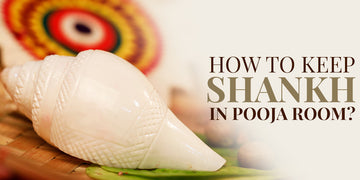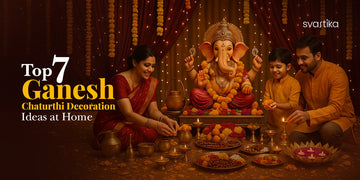Vishnu's emblem, the shankh, is revered in Hinduism and Buddhism. In the Mahabharata, Lord Krishna and the five Pandavas held a shankh, and shankh is often use for krishna idol decoration in temples or pooja room .
The shankh has evolved from ocean churning or Samudra Manthan. Out of "Pancha Maha Varna" or "Five Great Elements," a shankh is one of the Hindu ceremonial worships that signifies air and breath of life.
In Sanskrit, shankh or shankham translates for Shum, anything nice, and Kham, water. Shankham translates as "the conch that contains the sacred water." Shankh is placed in temples or pooja rooms along with other things for a variety of purposes.
In this blog, you will know the significance of shankh and recommendations for keeping it in good condition.
Significance of Shankh in Hinduism
The conch is said to be home to deities. Varun Dev lies at the conch's center, Brahma in the back, and goddess Ganga and goddess Saraswati in the front.
According to Hindu mythology, Lord Vishnu blows the shankh to remove evil in the universe in his numerous forms.
The conch is the ideal instrument for bringing positive energy into our minds and surroundings. Whereas the conch is a highly revered instrument, it is also thought to be Lord Vishnu's most formidable weapon.
Lord Vishnu is often depicted holding a Panchajanya Shankh, it is common to see Vishnu idols grasping this sacred conch.
A shankh is utilised at the commencement of prayers or any auspicious beginning in religious rites. The sound is associated with optimism and the clearing of hurdles. While performing religious activities, water held in a conch shell is sprinkled to wash and purify the room.
Two conches are classified: left-handed conch shells and right-handed conch shells. The fortunate is the right-handed conch, also known as Lakshmi Shankh or Dakshinavarti Shankh.
However, shankh is classified into two types according to the Vedic texts : 1) for blowing sound and 2) for devotion. It is stated that anyone who blows into the Shankh daily is immune to heart illness.
As a result, many individuals retain this precious sign in their homes.
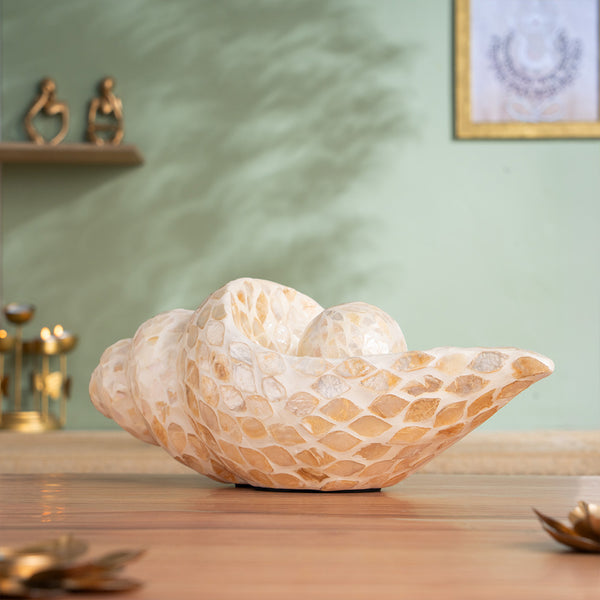
Luxury Artistic Conch Shell for Home Decor
How to Place Shankh in Pooja Room or Mandir

Follow these below steps to know how to place shankh in the mandir -
- Before placing the shankh, clean it. Shankh can be cleaned at a nice mahurat on Thursday or the Treasure.
- Keep the shankh in the pooja room with the pointed end facing the idols at all times.
- The shankh should be stored with the open section facing the ceiling and the beak on its side. It is believed that the energy and vibrations emitted by the idols go to the pointed area of the shankh and distribute positive energies throughout the house.
- A silver base that fits the size of the shankh is the finest way to put it.
- Spread a red cloth around the platform and place it in the sand.
- Shankh should be kept on the right side of the room.
- Load the shankh with crimson threads and rice.
- Draw the Swastika emblem on Shankh and worship it with sandal paste, flowers, incense, and light.
Rules for Using Shankh
Remember these Vastu rules to keep shankh in the mandir or your pooja room -
- Shankh should not be utilised to provide water to the deities when blown during prayers.
- After washing the shankh with holy water regularly, cover it with a white or crimson cloth.
- The conch shell should constantly be kept full of water at the worship site.
- Worship the shankh regularly, and make sure you blow into them at least twice a day.
- To eliminate bad energy, scatter water from the conch shell throughout the house.
- During any religious practice, the shankh should never be put above the Shivling or come into contact with the Shiv Pindi.
- Do not offer Lord Shiva idol or Lord Sun water with a shankh.
- Two conches should never be kept together for worship in a pooja room.
- Never leave a shankh on the floor since it is considered a divinity.
- Shankh that is broken or cracked should never be kept in the pooja room.
- Do not keep thorny conches and corals as decoration pieces since they cause an imbalance in the healthful environment of your home.
Benefits of keeping Shankh in Pooja Room
Few benefits of keeping shankh in the pooja room -
- Shankh attracts money and success when maintained at home.
- Shankh is thought to ward against bad energy while bringing calm and optimism into one's life.
- The presence of shankh in the home provides knowledge by invoking Goddess Saraswati.
- Blowing the shankh regularly in a Vastu-flawed house neutralises the Vastu doshas.
- The sound of Om emerges from the shankh when it is blown with the regulated breath, which helps the mind rest.
- You can hear the sound of the ocean when the shankh is held close to the ear.
Different types of shankh to keep in the Pooja Room
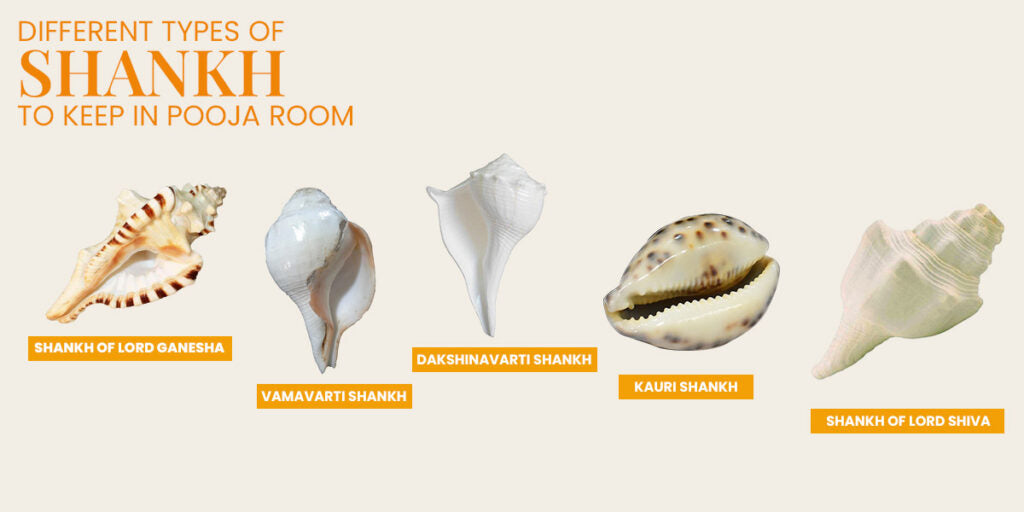
1. Shankh of Lord Ganesha
Ganesha shankh represents Lord Ganesha and is worshiped to eliminate barriers and provide success, knowledge, and great fortune.
This shankh is considered fortunate since it protects against harmful influences. Ganesha shankh is best kept in a home shrine and can be worshiped regularly or during religious holidays. It can also be stored in the house's locker, covered in crimson cloth.
This ganesha shankh is used in ganesha temples such as siddhivinayak temple of mumbai which is considered as one of the top richest temple in the world along with other temples like tirupati balaji and vaishno devi temple.
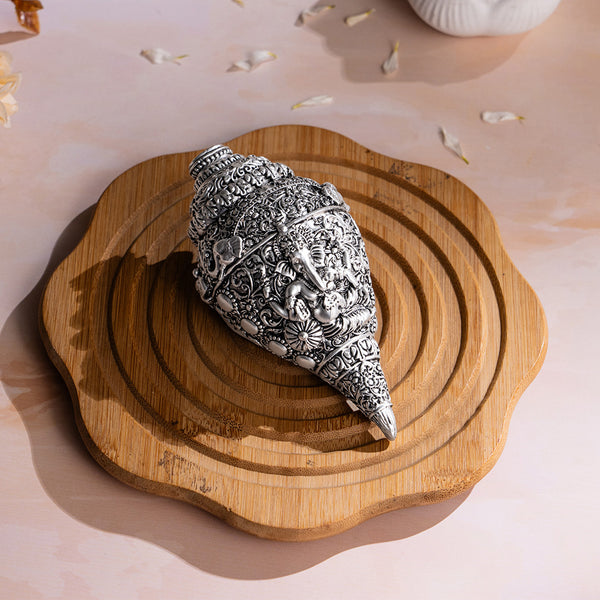
Ganesh Shankh (Conch) - Silver Plated (5 Inch)
2. Vamavarti Shankh
Vamavarti shankh opens towards the left hand, its mouth in the center. Vamavarti is the most prevalent shankh that is used for all religious occasions. It is used in the left hand.
It is said to be Goddess Lakshmi's brother and Lord Vishnu's favorite. It is said that when you blow the vamavarti shankh, it cleanses the environment and eliminates bad energy.
3. Dakshinavarti Shankh or Laxmi Shankh
The Lakshmi shankh is an alternate name for the dakshinavarti shankh. The Daksinavarta or Dakshinavarti shankh is open on the right side. It is considered the abode of Kuber, the deity of riches.
Because it has a closed mouth, it can only be worshiped and makes no sound. Right-handed shankhs are considered lucky, attracting good fortune, tranquility, and wealth.
Right-handed conch shells should be placed in north, east, or northeast puja rooms.
4. Kauri Shankh
According to Hindu myth, kauri, Lakshmi, and other sacred objects were retrieved from the Samudra Manthan. Kauri is considered Mahalakshmi's love product, according to Hindu shastras.
Moreover, it is connected with Lord Shiva and is used to adorn Nandi. Kauris have been believed to bring riches and prosperity since ancient times. It was used as cash in ancient times and was part of the bride's bridal outfit.
You can store kauri shankh in the cash box for prosperity and wealth.
5. Shankh of Lord Shiva
Some may know that shankh is not utilised in Lord Shiva's worship. According to mythology, Radha became enraged after witnessing Shri Krishna with her companion Virja and cursed them.
Sudama, Krishna's friend, became enraged while listening to Radha's wrathful comments. Sudama was cursed by Radha and became a demon known as Shankhchur.
He ascended to the throne of all three planets and began tormenting the sages and saints. At the same moment, Lord Shiva became enraged and killed Shankh chur.
As a result, water is provided to Vishnu and other deities from shankh, but as Lord Shiva killed Shankhchur, the shankh is considered prohibited in Lord Shiva worshiping.
Conclusion
Shanka is a great part of everyday puja and Navratri or other Hindu religious festivals. You have also learned about various advantages of keeping shankh at home in your prayer room or mandir.
Follow the Vastu rules while placing the shankh in the pooja room, as it not only brings blessings but also enhances your home decor with its spiritual charm.


